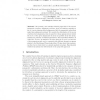Free Online Productivity Tools
i2Speak
i2Symbol
i2OCR
iTex2Img
iWeb2Print
iWeb2Shot
i2Type
iPdf2Split
iPdf2Merge
i2Bopomofo
i2Arabic
i2Style
i2Image
i2PDF
iLatex2Rtf
Sci2ools
IDA
2007
Springer
2007
Springer
Learning to Align: A Statistical Approach
We present a new machine learning approach to the inverse parametric sequence alignment problem: given as training examples a set of correct pairwise global alignments, find the parameter values that make these alignments optimal. We consider the distribution of the scores of all incorrect alignments, then we search for those parameters for which the score of the given alignments is as far as possible from this mean, measured in number of standard deviations. This normalized distance is called the ‘Z-score’ in statistics. We show that the Z-score is a function of the parameters and can be computed with efficient dynamic programs similar to the Needleman-Wunsch algorithm. We also show that maximizing the Z-score boils down to a simple quadratic program. Experimental results demonstrate the effectiveness of the proposed approach.
| Added | 08 Jun 2010 |
| Updated | 08 Jun 2010 |
| Type | Conference |
| Year | 2007 |
| Where | IDA |
| Authors | Elisa Ricci, Tijl De Bie, Nello Cristianini |
Comments (0)

